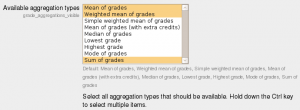Category aggregation
The aggregation dropdown menu lets you choose the aggregation strategy that will be used to calculate each participant's overall grade for a grade category. The different options are explained below.
The grades are first converted to percentage values (interval from 0 to 1), then aggregated using one of the strategies below and finally converted to the associated category item's range (between Minimum grade and Maximum grade).
Important: An empty grade is simply a missing gradebook entry, and could mean different things. For example, it could be a participant who hasn't yet submitted an assignment, an assignment submission not yet graded by the teacher, or a grade that has been manually deleted by the gradebook administrator. Caution in interpreting these "empty grades" is thus advised.
Mean of grades
The sum of all grades divided by the total number of grades.
A1 70/100, A2 20/80, A3 10/10, category max 100: (0.7 + 0.25 + 1.0)/3 = 0.65 --> 65/100
Weighted mean
Each grade item can be given a weight, which is then used in the arithmetic mean aggregation to influence the importance of each item in the overall mean. In simple terms, the category "total" will be equal to the sum of the scores in each grade item, these scores being multiplied by the grade items' weights, and that sum being finally divided by the sum of the weights, as shown in this example.
A1 70/100 weight 10, A2 20/80 weight 5, A3 10/10 weight 3, category max 100: (0.7*10 + 0.25*5 + 1.0*3)/18 = 0.625 --> 62.5/100
Simple weighted mean
The difference from Weighted mean is that weight is calculated as Maximum grade - Minimum grade for each item. 100 point assignment has weight 100, 10 point assignment has weight 10.
A1 70/100, A2 20/80, A3 10/10, category max 100: (0.7*100 + 0.25*80 + 1.0*10)/190 = 0.526 --> 52.6/100
Mean of grades (with extra credits)
Arithmetic mean with a twist. An old, now unsupported aggregation strategy provided here only for backward compatibility with old activities.
A value greater than 0 treats a grade item's grades as extra credit during aggregation. The number is a factor by which the grade value will be multiplied before it is added to the sum of all grades, but the item itself will not be counted in the division. For example:
- Item 1 is graded 0-100 and its "Extra credit" value is set to 2
- Item 2 is graded 0-100 and its "Extra credit" value is left at 0.0000
- Item 3 is graded 0-100 and its "Extra credit" value is left at 0.0000
- All 3 items belong to Category 1, which has "Mean of grades (with extra credits)" as its aggregation strategy
- A student gets graded 20 on Item 1, 40 on Item 2 and 70 on Item 3
- The student's total for Category 1 will be 95/100 since 20*2 + (40 + 70)/2 = 95
Median of grades
The middle grade (or the mean of the two middle grades) when grades are arranged in order of size. The advantage over the mean is that it is not affected by outliers (grades which are uncommonly far from the mean).
A1 70/100, A2 20/80, A3 10/10, category max 100: 0.7 + 0.25 + 1.0 --> 0.70 --> 70/100
Smallest grade
The result is the smallest grade after normalisation. It is usually used in combination with Aggregate only non-empty grades.
A1 70/100, A2 20/80, A3 10/10, category max 100: min(0.7 + 0.25 + 1.0) = 0.25 --> 25/100
Highest grade
The result is the highest grade after normalisation.
A1 70/100, A2 20/80, A3 10/10, category max 100: max(0.7 + 0.25 + 1.0) = 1.0 --> 100/100
Mode of grades
The mode is the grade that occurs the most frequently. It is more often used for non-numerical grades. The advantage over the mean is that it is not affected by outliers (grades which are uncommonly far from the mean). However it loses its meaning once there is more than one most frequently occurring grade (only one is kept), or when all the grades are different from each other.
A1 70/100, A2 35/50, A3 20/80, A4 10/10, A5 7/10 category max 100: mode(0.7; 0.7; 0.25; 1.0; 0.7) = 0.7 --> 70/100
Sum of grades
The sum of all grade values. Scale grades are ignored. This is the only type that does not convert the grades to percentages internally. The Maximum grade of associated category item is calculated automatically as a sum of maximums from all aggregated items.
A1 70/100, A2 20/80, A3 10/10: 70 + 20 + 10 = 100/190
When the "Sum of grades" aggregation strategy is used, a grade item can act as Extra credit for the category. This means that the grade item's maximum grade will not be added to the category total's maximum grade, but the item's grade will. Following is an example:
- Item 1 is graded 0-100
- Item 2 is graded 0-75
- Item 1 has the "Act as extra credit" checkbox ticked, Item 2 doesn't.
- Both items belong to Category 1, which has "Sum of grades" as its aggregation strategy
- Category 1's total will be graded 0-75
- A student gets graded 20 on Item 1 and 70 on Item 2
- The student's total for Category 1 will be 75/75 (20+70 = 90 but Item 1 only acts as extra credit, so it brings the total to its maximum)
Available aggregation types
In Moodle 1.9.5 onwards, a new available aggregation types setting in Administration > Grades > Grade category settings enables administrators to reduce the number of aggregation types.
Note that reducing the number of aggregation types simply results in disabled aggregation types not appearing in the aggregation type dropdown menu. All existing grade category calculations remain the same, regardless of whether the aggregation type is later disabled by an administrator.
